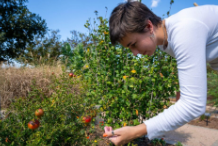Fruit trees benefit from fertilization around the bloom period, but the amount needed varies with the age of the tree. Normally, trees primarily need nitrogen, so the recommendations are for a high nitrogen fertilizer such as a 27-3-3, 29-5-4, 30-3-3 or something similar. Though recommended for lawns, these fertilizers will also work well as long as they do not contain weed killers or crabgrass preventers. Use the following rates:
Trees 1 to 2 years old, apply one-fourth cup of fertilizer per tree;
Trees 3 to 4 years old, apply one-half cup per tree;
Trees 5 to 10 years old, apply 1 to 2 cups per tree;
Trees more than 10 years old, apply 2 to 3 cups.
You may also use nitrate of soda (16-0-0) but double the rate recommended above. If a soil test calls for phosphorus and potassium, use a 10-10-10 but triple the rate.
On apple trees, last year’s growth should be 8 to 10 inches, cherries should have 10 to 12 inches, and peaches should equal 12 to 15 inches of terminal growth. If less than this, apply the higher rate of fertilizer, and if more, apply the lesser amount.
Spread all fertilizer evenly on the ground away from the trunk of the tree and to the outer spread of the branches. Water in the fertilizer with at least 1/4 inch of water if rain does not do the job for you.
Fertilizing Grapes
Year of Planting: Apply one-half cup of a 10-10-10, 12-12-12 or similar fertilizer per vine as growth begins in the spring. Repeat after one month. Fertilizers should be spread evenly from the trunk out 3 to 5 feet.
Second Year: Apply 1 cup of a 10-10-10, 12-12-12 or similar fertilizer per vine as growth begins in the spring. Fertilizers should be spread evenly from the trunk out 3 to 5 feet.
Mature Vines (3 years and older): If the soil test recommends phosphorus and potassium, use a 10-10-10, 12-12-12 or similar fertilizer at the rate of 2 cups per mature vine. Fertilizers should be spread evenly from the trunk out 3 to 5 feet.
If, however, there are adequate levels of phosphorus and potassium, add 3/4 cup of a high nitrogen fertilizer such as a 27-3-3, 29-5-4, 30-3-3 or something similar instead of the 10-10-10. Though recommended for lawns, these fertilizers will also work well as long as they do not contain weed killers or crabgrass preventers. Fertilizers should be spread evenly from the trunk out 3 to 5 feet.
Ward Upham, Extension Agent




